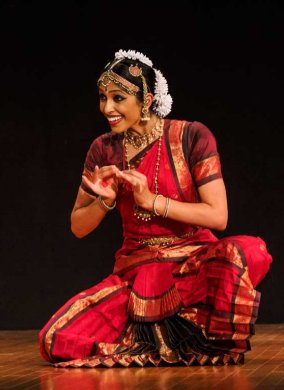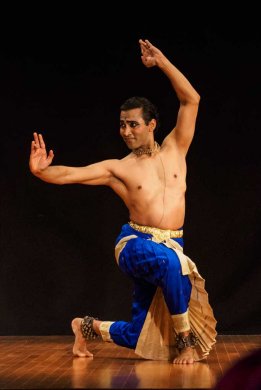
|   |

|   |
Hari Hara by Ganesh Vasudeva and Nadhi Thekkek - Priya Das e-mail: priyafeatures@gmail.com April 20, 2016 Nadhi Thekkek and Ganesh Vasudeva, both Bharatanatyam artists in the Bay Area, presented Hari Hara at Shirdi Sai Parivar, Milpitas, California, on April 2, 2016. Given the title, it was a bit disappointing when it became apparent that Nadhi and Ganesh would be dancing separately. However, the above-average performances by both certainly made up for it.  Nadhi Thekkek
Nadhi started with a crisp Simhendramadhyamam-adi Pushpanjali marked by clean bodylines and unfettered choreography by A. Lakshmanaswamy. Some of the steps were on her toes, which was a novelty. There was neutrality in her expression though; a little more involvement would have made a good presentation great. The varnam Innum En Manam was next. Nadhi’s nayika was an idealist; quiet, with a high threshold of tolerance. So when she asked, "Is it fair that you ignore me?" she was not angry or desperate. It was asked with a sense of entitlement, almost as if she was trying to figure out what else she could have done to ensure an audience with Krishna. Again, A. Lakshmanswamy’s no-frill choreography shone here and blended particularly well with Nadhi’s own minimalist style. Or was the choreography that veneered Nadhi’s execution? – one could not tell where the inspiration ended and the presentation began. The first set of padartha was masterful; each repeated word had a distinct depiction. The character portrayals were not heavy-handed at all: Krishna shifted into nayika with a light touch but this was clearly discernible; with intelligent use of tilt-of-body and outstretched foot (front tilt for a nayika in longing, back-tilt with out-stretched foot to show Krishna holding back). The quality of music felt like a live orchestra. Other highlights included the many, many ways in which the lotus was shown; the emotion was carried into the Aradhi; the contrast between the bliss of the nayika’s memories and the loneliness of her current state was skillfully woven. The only abhinaya that did not ring true was Putana, she was too benign. And at times, the nritta would have benefitted from more energetic footwork. Thumaka Chalata was the other Harirupa, in terms of avatara and as a child. Kausalya’s astonishment at seeing her son apparently walking for the first time was adroitly shown. Other highlights here were when she quiets the bird, so she can hear her son chirping; inviting the child Rama to look into a mirror to express "Raghuvara chabi ke samaan" and ending with giving him a bow and arrow as a portrayal of motherly pride in her son’s growth. Nadhi must correct the script for this piece though, it was written by Tulsidas. Nadhi’s Hari was a showcase of A. Lakshmanswamy’s choreography and her own talent as a dancer. Overall, the only cautionary comment to be made is the overuse of broad smiles, as it detracts from the narrative. For the next hour, Ganesh Vasudeva manifested Hara in compositions emphasizing truth, beauty, devotion, and love. His sthayi personality contrasted with Nadhi’s nayika: His was a Lord who held little back, hers was a nayika in self-imposed restraint. Ganesh’s first piece was Paramananda Natana in Kedara –adi by Swati Thirunal. It was his own choreography, and lived up to the quality one has come to expect from him. It was balanced in that it leveraged upper and lower body, abhinaya and nritta, brevity and sanchari. The depiction of the lotus with a long stem that emanated at the navel and morphed into the curves of Shiva’s eye was particularly memorable. The varnam, Sami Ninne Kori, in Ragamalika-rupaka followed. The music was intriguing, the bhava elements were sung by D. S. Srivatsa Paramananda, strong sollukattu by Guru Narmada. Ganesh had a few interludes of attami coupled with eyebrow movement, not often seen in Bharatanatyam. Ganesh’s nayika was unabashed in her expectation of attention or reciprocity. She says, “You and I are like the moon and its light; can a flower be separated from its fragrance?”  Ganesh Vasudeva
Ganesh’s heroine was not overly effeminate, and he always sprang back to his own self during the nritta or when depicting the lord. Ganesh’s jathis were crisp - as usual, one got to see unique ways to incorporate alapadmakaha and katakamukhaha combinations. There was one jathi where the emphasis was on the use of patakas which appealingly turned into dola-hastas. Gopalakrishna Bharathi’s Eppo varuvaro in Jonpuri was next. It’s a tricky piece to attempt, both from choreographic and presentation perspectives, since it has bhakti as the sthayi bhava, but has several narratives: Shiva as the mediator between Brahma and Vishnu, as the consort of Meenakshi, as Nataraja. Ganesh moved through these visages effortlessly, always coming back to a heartfelt "Eppo varuvaro." The concluding piece, Hariyum Haranum in Atana-roopaka, asked, “Doesn’t the world know that Hari and Hara are one?” This piece is even trickier to perform: Hari and Hara’s angikabhava is different and the switches between them need to be made carefully. Serenity and dynamism have to be juxtaposed in the context of worship, but Ganesh pulled this off, one minute he was the serpent that Vishnu stretched out on, the next, he was Shiva who grabs the snake and wears it. “Hari has Lakshmi on his chest, Hara has Uma as his left half” was also done well. The next time, Ganesh must think more about the repeated words "endru ariyatharum ularo" – a different expression can be delivered each time: humble rhetoric, incredulity, friendly encouragement, serious consideration, quiet wisdom. Overall, if a comparison were to be made, however unfair it is to do so, between his original thematic Bharata, and this performance, one felt he had been able to completely surrender to the art and to the Divine in the former, he came close to it in the latter. Priya Das is a writer based in San Francisco Bay Area, USA, covering extraordinary nuances of everyday life with a focus on the performing arts. She is a regular contributor to India Currents, a magazine reaching more than 170K readers on - and offline. Some of her writing is at priyafeatures.com |